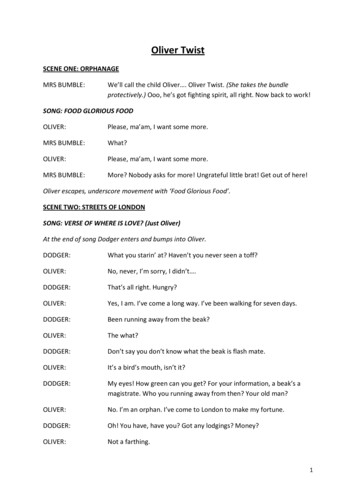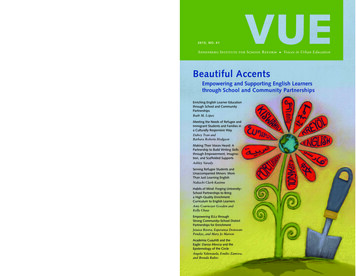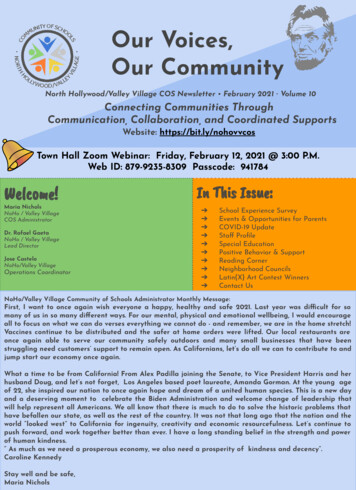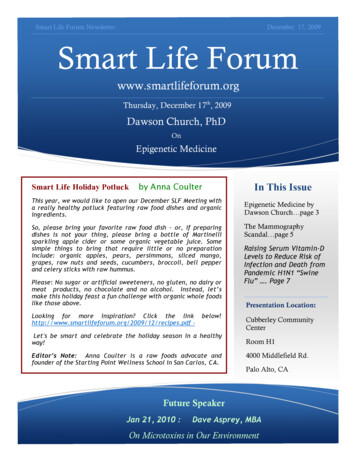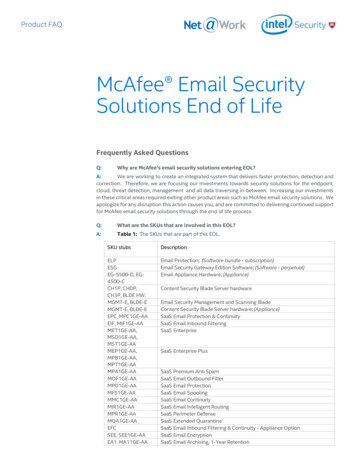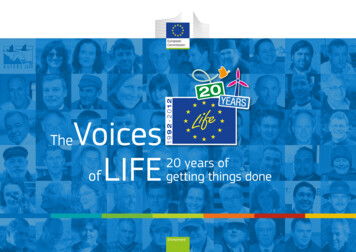
Transcription
TheVoicesof LIFE20 years ofgetting things doneEnvironment
European CommissionEnvironment Directorate-GeneralLIFE (“The Financial Instrument for the Environment”) is a programme launched by the European Commission and coordinated by the EnvironmentDirectorate-General (LIFE Units - E.3. and E.4.).The contents of the publication “The Voices of LIFE: 20 years of getting things done” do not necessarily reflect the opinions of the institutions of the European Union.Authors: Gabriella Camarsa (Environment expert), João Pedro Silva (Nature expert), Justin Toland, Eamon O’Hara, Tim Hudson, Wendy Jones, Jon Eldridge, Ed Thorpe, ChristopheThévignot (AEIDL, Communications Team Coordinator). Managing Editors: Angelo Salsi and Hervé Martin, European Commission, Environment DG, LIFE E.3 and E.4 – BU-9, 02/1,200 rue de la Loi, B-1049 Brussels. LIFE Focus series coordination: Simon Goss (LIFE Communications Coordinator), Valerie O’Brien (DG Environment Communications Coordinator). Production: Monique Braem (AEIDL). Graphic design: Daniel Renders, Anita Cortés (AEIDL). Photos database: Sophie Brynart. Acknowledgements: Many thanks toall the people who agreed to be interviewed for this publication. Thanks also to everyone across Europe who helped arrange interviews and provided feedback, photos and otheruseful material for this report. Photographs: Unless otherwise specified, photos are from the respective projects. This publication is published in English with a print of 10 000copies and is also available online.Europe Direct is a service to help you find answers to your questions about the European Union.New freephone number: 00 800 6 7 8 9 10 11Additional information on the European Union is available on the Internet. It can be accessed through the Europa server (http://europa.eu).Luxembourg: Office for Official Publications of the European Union, 2012ISBN 978-92-79-22675-5doi:10.2779/86780 European Union, 2012Reproduction is authorised provided the source is acknowledged.Printed in BelgiumPrinted on recycled paper that has been awarded the EU Ecolabel for graphic paper (http://ec.europa.eu/ecolabel/)
T h eV o i c e so fL I F E2 0y e a r so fg e t t i n gt h i n g sd o n e1Europe’s wildlife and natural resourceshave been benefitting from LIFE support for 20 years. It was back in 1992when the EU’s financial instrument forthe environment first opened its doorsto help provide co-finance for projectsinvolved in implementing Europeanenvironmental policy. Much of thisinitial work concentrated on launchingactions through the then 12 MemberStates to establish an embryonic Natura 2000 network. Since then, LIFE’smandate has grown and flourished. Ithas strengthened its focus on natureconservation and expanded its reachto a wide range of environmental protection and information disseminationservices. Today, LIFE is operating inall 27 Member States, where it continues to build on itsimpressive portfolio of results in tackling key challengessuch as biodiversity decline, habitat loss, resource efficiency and climate action, among other important intervention areas.Central to LIFE’s success has been the role of people.Therefore what better way to mark the 20th anniversaryof the programme than to focus on the people who havehelped LIFE to get things done? These include the coordinators and team members from the more than 3 500projects over the last two decades who have investedTo hear these individuals, communities and businesses in their ownwords is to understand directly thevalue, impact and inspiration of LIFE:its value as a source of support forestablished conservation organisations and programmes; its impacton people who took a new interestin nature and the environment as aresult of their interaction with theprogramme; and its inspiration forcountless green business initiatives.their time and energy converting LIFE funds into practical, tangible, on-the-ground benefits for Europe’s environment. They also include the politicians from local,regional, national and European levels who have persistently backed and promoted LIFE’s case throughout theyears. Equally important are all the tens of thousands ofindividuals from the local communities and businesseswho have participated in LIFE projects and contributedto their accomplishments. Not forgetting of course thededicated personnel from countless governing bodies around Europe who have administered and steeredLIFE’s outputs so effectively since 1992.We’ll hear the voices of people fromall over the EU - and indeed fromneighbouring countries - whose experiences reflect the LIFE programme’sbroad perspective on the relevanceof holistic support for Europe’s environment as a whole.We hope you will find this publication both enlightening and inspirational. The stories it contains demonstrate LIFE’s considerable scope for connecting witha wide cross-section of different peoples’ environmental convictions. They also underscore the passion and commitment that exists for sustaining ourenvironmental inheritance. Together, they show thatLIFE remains in good stead to continue its productiveand popular support for Europe’s environment into thenext 20 years.FOREWORDCelebrating 20 yearsof LIFE’s people
CONTENTS2T h eV o i c e so fL I F E2 0y e a r so fg e t t i n gt h i n g s4 Behind the scenesLifting the lid on the LIFEprogramme. 5The founding father. 5The namer. 6The legislator . 7The leader. 7The energiser .10The good neighbour.11The “LIFEer”.12The helper.13The monitoring team coordinator.14The monitor.14The communicator.151d o n e16 MEET THE COMMUNITIES2LIFE and the regionalrecord-breaker.17A city-wide environmentof innovation.18Building a partnershipfor better city living.20LIFE the ‘trigger’ for two decadesof restoration.22LIFE’s help for the forests ofthe Holy Community ofMount Athos.24Positive partnership memoriesfrom a neighbouring state.26Combatting marinepollution in the Med.28Building river restorationcommunities through LIFE.30Waiting for the flood.32Biomass boilers improvevillage life in Slovakia.33Helping agriculture to innovate.34
T h e36 MEET THE CITIZENSLIFE involves residentsin initiatives to meetKyoto obligations.37Snakes Alive!.38Art for LIFE’s sake.40A special week for wastereduction.42A Finnish household embracesLIFE waste prevention .44Turning rivers into a classroom.45Children’s friend Boo.47LIFE builds relationshipsto tackle heath fires.49LIFE lays a foundationfor renewable building.523V o i c e so fL I F E2 0y e a r so fg e t t i n g56 MEET THE GUARDIANS4A passion for conservationwith ponies.57Fostering a fondness for nature.59View from a Swedish plateau.62Crofting is a LIFE choice.63LIFE’s graziersof the Hungarian grasslands.66Living with the wolf at the door.69Turning the tide on seaturtle conservation in Sardinia.71Helping a Rhine fishermanachieve a lifelong dream.74Solving a biogas problem.76Pig farming cleans up its act.77Linking LIFE to the farmon Anglesey and Lleyn.79t h i n g sd o n e380 MEET THE BUSINESSESBuilding the BASTA.81Cooling off the greenhouse gases.82Distributing healthy foodwithout causing harm.84A breakthrough ‘biotyre’.87Research and reuse of winery‘wastes’ continues to grow.88The brewer: A toastto nature conservation.90LIFE marks ‘turning point’for rural tourism in Latvia.92Restoring national pridein North Karelia.94Camping: “It’s a way of life!”.95LIFE 20 years competition.975
41Behind the scenesFrom its conception over 20 years ago, through its development duringsuccessive programming periods, many aspects of the LIFE programmehave remained somewhat invisible to the wider public. In this sectionof the brochure we shine the spotlight on some of these “behind thescenes” activities and on some of the people and organisations thathave helped to make LIFE the programme it is today.
V o i c e so fL I F E2 0y e a r so fg e t t i n gt h i n g sd o n e5BEHIND THE SCENEST h eLifting the lidon the LIFE programmeThe founding fatherOften credited with being the father of LIFE, retired Member of the European Parliament (MEP),Hemmo Muntingh, still has a strong attachment tothe programme he helped to establish more than20 years ago.From the modest 70 million programme that was established in 1992, the LIFE programme, with a currentbudget of over 2 billion, is now firmly established asthe EU’s main financial instrument for the environment.However, for Hemmo Muntingh this outcome was not always certain.The story of LIFE began in 1989, when Mr Muntingh wasseeking to hold his seat in the European Parliament (EP),having first been elected in 1979. During the electioncampaign, his party, the Dutch Labour Party (Partij vande Arbeid, PvdA) proposed the idea of a European Environment Fund. ”In fact, this was already party policy andI asked for it to be included in the election programme,”he recalls.Once re-elected, Mr Muntingh set about making goodon his election promise, and when the opportunity aroseduring the Parliament’s budget procedure in 1989, heincluded an amendment proposing a budget line for anEnvironment Fund. “As a goal, I mentioned an amountthat would be equivalent to 1% of the total EU budget in1995. The European Parliament accepted the proposal,but in the joint decision of the European Council and theEuropean Commission the budget contained only a PM1,without an amount.”Not perturbed, Mr Muntingh redoubled his efforts duringthe budget procedure of 1990. “I tried it again the following year, this time via the Parliament’s environmentcommittee, and an amount of ECU 31 million was introduced to the budget. The EP’s budget committee accepted this amendment of the environment committeeand also declared it a priority of the EP. There was even afurther amendment in the budget committee to raise theamount from ECU 31 million to ECU 81 million.”The EP, in its first reading of the budget, accepted thisproposal but once again it ran aground in the Council,where for a second time, the budget amount was replacedwith a PM. “Of course, the EP reintroduced the ECU 81million in the second reading but during the very difficult1. P.M or Pro Memory, a procedure used to inscribe a budget line without specifying an amount.negotiations that followed it had to be withdrawn. However, a budget amount of ECU 31 million, the amount Ihad originally proposed, was eventually accepted. It wasHemmo Muntingh
V o i c e so fL I F Enot as much as the EP wanted but it was an importantstep forward - ‘reculer pour mieux sauter’ as they say!”During its passage though the institutions, the Environmental Fund acquired the name by which it eventuallycame to be known: LIFE. “As far as I remember, the name,l’Instrument financier pour l environnement (LIFE), wasThe namerAlain Lamassoure, the French MEP who playeda large role in establishing the LIFE programme,says that he got the idea for its name after dinner one night in his hotel room in the Métropole,Brussels. LIFE is in fact an acronym: L’InstrumentFinancier pour l’Environnement (“financial instrument for the environment”).Alain LamassoureMr Lamassoure’s original idea was to create anextra Structural Fund. “There were already three Structural Funds: regional,social and rural development. It was a period when environmental concernsstarted to appear in most Member States, and my original idea was tocomplement the three Structural Funds with one dedicated to protecting theenvironment,” he says.While a programme with financial means was agreed, it did not go so far asa Structural Fund. Mr Lamassoure regrets that the amount of funds available was not higher, but he says that “it has been very helpful in manycountries, particularly on biodiversity and now new renewable energies.Hopefully, it will be beefed up in the next general framework.”“It’s become a very important programme in the EU It’s my child, but it’sgrown up. I’m proud of it but I trust those in charge in the Commission andthe Parliament to reorient it whenever necessary and point it in the rightdirection,” he says.2 0y e a r so fg e t t i n gt h i n g sd o n einvented by the rapporteur of theEP’s budget committee, Mr AlainLamasourre.” (See box: The namer)The story did not end there, however,and it soon emerged that the Commission and the EP had very different ideasabout how the new programme should beoperationalised. “The controversy became sohot that the EP resorted to an unusual method tosafeguard its position: it blocked the creation of any newposts in the Commission until such time as it came upwith an acceptable proposal for LIFE. The Commissionresponded by drawing up a new Regulation for LIFE. Isaw the first concept andit seemed okay, and because I was the rapporteur for the environmentcommittee in the EP I hadthe possibility to steer thefinal concept in the rightdirection.““I am retired now and I have to contentmyself with the beautiful nature in my garden here inFriesland. But I still follow LIFE from a distance and I ampleased to see the very good work it has been doing fornature conservation. I canonly hope that this continues in the future. In thecoming years I think theenvironment and naturein the newer EU MemberStates will come underintense pressure arisingfrom the implementationof the EU’s agriculture and regional policies. I hope thatLIFE can help to offset this and demonstrate how we cando things differently in future, and avoid the mistakes ofthe past.”“T h e6I am very proud of LIFE and thecontribution it makes, especiallyto nature conservation, which hasalways been my passion in life“I could tell you a lot more about this. In fact, I alreadyintroduced the concept of an Environment Fund in theEP in 1979 and 1980. But it was not accepted. So, forover 10 years I had to fight all the way. But it was worthit. The environment and nature conservation has beenmy life’s work. Even before I became an MEP I was theDirector of the Dutch Society for the Preservation of theWadden Sea (Waddenvereniging). All my life, even as ayoung boy, I have always been happiest when I am closeto nature; bird watching or trying to get a glimpse ofsome special plant or animal.
o fL I F E2 0y e a r so fg e t t i n gt h i n g sd o n eThe legislatorThe leaderThe results and findings of LIFE projects havestrong implications for policymakers and over thepast 20 years have impacted on legislation on awide range of issues. In one area, in particular,LIFE projects were a very useful instrument forshaping policy: the management of coastal zones.Anne Burril, Deputy Head of Unit, DG ENV, workedon the drafting of the recommendation on Integrated Coastal Zone Management.The LIFE programme has seen many changes anddevelopments in its 20-year history, but for mostof this time there has been at least one constant– Angelo Salsi, the current head of the LIFE NatureUnit.Europe’s coasts required a joined-up approach to management, but the EU recognised that it was “a very complexarea”, says Anne Burrill. ”We didn’t think that it was a verygood idea for us to sit in our office and try to make up asolution, so we decided that the best thing to do was toactually have some private projects, some experience thatwe could draw on.”LIFE was the main instrument for financing this demonstration process, accounting for around two-thirds of theprojects (some 20 projects were launched in 1995). Otherprojects were financed under the INTERREG programme.“These were private projects that we were doing to test outdifferent approaches to integrated coastal management tosee what works well and what doesn’t,” she says.A team of consultants also worked on the initiative. “Theywere looking at the particular aspects of the pilot projects.For instance, there was this one fellow who was lookingat legal aspects of the different projects. Another onewas looking at public participation aspects. There weresix themes in total,” says Ms Burrill. This process led tothe publication of a summary of the main finding of theprojects, followed by a public consultation on the future ofcoastal management. A recommendation was preferred toAnne Burrila directive, and on 30 May 2002, a European Parliamentand Council Recommendation concerning the implementation of Integrated Coastal Zone Management in Europewas adopted.Ms Burrill says that one of the chief advantages of LIFE isits geographical reach. “Our projects were spread acrossEU countries. LIFE was the only vehicle that had in-depthand relatively long-term input from sample sites acrossthe whole EU.”The Deputy Head of Unit explains that she “managed thepolicy up to [the point] where the recommendation wasbeing adopted and have somewhat followed it since then.Because of the sensitivity of some of the issues, particularly the relationship to land use planning, it was decidedthat the best approach was to allow quite a lot of flexibilityand to use a recommendation. We saw in the pilot projectsquite a considerable range of approaches in different countries. So the recommendation that came out was a seriesof principles that we had derived from the pilot projects. Itmandates the Member States to set national policies onintegrated coastal management and it sets out the kind ofthings should be covered in these policies.”According to Ms Burrill, the Barcelona Convention on coastal management, which established a protocol for Mediterranean countries, was “very much inspired by the EU recommendation”.A native of Bolzano, in the north of Italy, Mr Salsi joinedthe European Commission in 1994, having previouslyworked as an agro-meteorologist for the regional government of Emilia-Romagna. Since then, his career pathhas been closely aligned to development of the LIFE programme, having moved from being a LIFE Desk Officer toDeputy Head of the LIFEUnit, to his current position as Head of the LIFENature Unit.“7BEHIND THE SCENESV o i c e sThe concerns that led tothe creation of LIFE are still there“I feel very honoured to be part of this experiment, andthis community of people. From those who manage theprogramme to the beneficiaries and the Member States,there is a great sense of pride in what we are trying toachieve, and for me, LIFE’s best days are still to come.”“T h eFrom its conception in the early 90s, Mr Salsi believesthat LIFE is now reaching a stage of maturity as a programme, having won the appreciation and confidence ofbeneficiaries and those outside the programme.“The concerns that led to the creation of LIFE are stillthere, they have not gone away, and I fear that the environment will continue to need public investment formany years to come. Twenty years have gone by butthis has not made this instrument any less relevant. Ifyou think of it in human terms, I would say we are atthe end of our teens and we are now becoming an adultAngelo Salsi
T h e8V o i c e so fL I F E2 0y e a r so fg e t t i n gt h i n g sd o n eto suggest that the project methodology was integrated into the RDP.Making it workWith responsibility for one of the three main components of the LIFE programme, Mr Salsi will have a keyrole to play in realising these future ambitions.“My job is to make sure the machine works, not just inabsolute terms but also in terms of the time and resourceconstraints we have to work with. But as well as ensuring that the administrative machinery works, I also havea programme that is not just about administration butabout improving our environment. You have to make surethere is a balance between the two elements and that themeans don’t prevail over the scope – this is my big task.”The moment people start toperceive land and nature as a partof our shared heritage, just likehistorical sites or precious artcollections, it will be become amajor unifying force that will gowell beyond what we imagineSince becoming head ofthe LIFE Nature and Biodiversity Unit in 2009, MrSalsi has worked hard atachieving this balanceand at ensuring better integration between the financial instrument and the policy.“When I first joined the Commission, the same Unitthat was responsible for nature policy was also responsible for the nature component of LIFE; theywere two sides of the same coin. At the time I wasthe Desk Officer responsible for the implementationof EU nature policy (Birds and Habitats Directives) inItaly and Romania, but I was also responsible for LIFENature projects in these countries. I remember onone occasion I was reviewing the Rural DevelopmentProgramme (RDP) for an Italian region and I noticedthere was a specific measure to target a certain typeof forest habitat, but I also knew that an Italian LIFEproject had done some work in this area so I was able“who knows its abilities and potential and is looking to thefuture with even bigger ambitions than before. This isreflected in the Commission’s proposal for the new LIFERegulation for 2014-2020, which is more innovative andambitious, while also preserving the key elements thathave made LIFE a success.”““Since 2000, the policy units and the LIFE programmehave been managed separately and this has made integration more difficult. So the day after I was appointedHead of Unit, the first thing I did was to set up a strategy to improve the bridgebetween these units, and thishas already started to paydividends. In the last couple ofyears we have been involvedin 10-15 court cases relatingto the protection of a bird orsite, for example. The policyunits would instigate thesecases but we would supportthem by providing informationor data gained from projectson the ground.“In fact, just yesterday I received an e-mail from a colleague who identified a potential problem in relation tocertain species in France, linked to the building of roads.This information comes directly from a LIFE project andcould result in action being taken by our policy units.”Integration also has an important strategic functionand Mr Salsi is particularly proud of the role LIFE hasplayed in the development of the Natura 2000 network, which he considers to one of the programme’smost important contributions over the last 20 years.“In the 1990s we wanted LIFE to support the drawingup of inventories of potential Natura 2000 sites. Six or
V o i c e so fL I F E2 0y e a r so fg e t t i n gt h i n g sd o n e9BEHIND THE SCENEST h eseven countries did it and it was a major step forward,really, a huge one. You have to think that counties likeSpain and Italy prepared all their inventories, whichlater led to the designation of Natura 2000 sites,through LIFE projects.“Once the sites were designated, the next issue toaddress was management. So we said to the Member States, ‘use LIFE money to develop a systemfor preparing and adopting management plans’. InFrance, there was a major project that led to what iscalled the ‘document d’objectifs’, which now providesa template for site management planning. Italy didthe same thing and other countries also followed suit.Thousands of management plans have since been developed through LIFE projects.”More recently, LIFE has also made an important contribution to the development the Natura 2000 networkof marine sites. “LIFE Nature has been a very efficienttool in developing techniques and indicators to identify and survey areas that could be designated. Thismarine network of sites now covers several hundredthousand square kilometres and a lot of this is due toLIFE projects.”Future prioritiesLooking to the future, Mr Salsi believes that integration and Natura 2000 will remain key priorities for theLIFE Nature and Biodiversity component. “An important feature of the new Regulation is the inventionof what we call ‘integrated projects’. From a natureperspective, these projects are there to further support the management of Natura 2000.“Natura 2000 won’t solve all our problems, but it is sohuge and such an enormous challenge that it wouldn’tmake sense to start diluting our efforts now, especially when we are so close to realising this incredible achievement. You have to remember, we’re talkinghere about 18% of the EU territory, and I wouldn’t besurprised if we double this in the coming years. If weeven make sure that half or two-thirds of this isreasonably well implemented it will make a majorchange in the way we perceive nature and theenvironment.“The moment people start to perceive land andnature as a part of our shared heritage, justlike historical sites or precious art collections,it will be become a major unifying force thatwill go well beyond what we imagine. Unfortunately, we have been brought up to believe thata large chunk of our happiness comes from ourmaterial happiness, but studies show that this isabsolutely not true. Happiness can also be foundin seeing a beautiful landscape or sitting on anice beach.“We have to change perceptions and I believe LIFE projects are playing a part in this and will play an evenmore important part in the future. Since 1992, LIFENature has been financing more or less thesame kind of activity, year after year, projectafter project. If you want to build a house andyou don’t have the money to buy all the bricks on dayone, you buy a brick every other week and after manyyears of buying bricks you eventually have a house. Atthis stage, we have built a pretty solid foundation. Inanother 20 years I hope we will have a house.”
T h e10V o i c e so fL I F E2 0y e a r so fg e t t i n gt h i n g sd o n eThe energiserAfter 10 years in the LIFE unit doing “a bit of everything”, Anne Louise Friedrichsen has lost noneof her passion for seeing first-hand the impact ofLIFE projects. “When you go on visits, it really becomes concrete what they’re doing. You come backfull of energy and you can see the point,” she says.Anne Louise FriedrichsenThough her current role in the LIFE Environment and Ecoinnovation Unit as Deputy Head of Unit has limited heropportunities for on-site visits, it was this contact withpeople on the ground that attracted her to join the team.Educated as a political scientist, Anne Louise beganworking for the Commission in 1995, first for DG Education and Culture. Since 2001 she has been a Desk Officerfor Denmark and Sweden, both for environment and nature projects, and has been involved in the organisationof a special conference on water and the ex-post evaluation of 10 years of the LIFE programme. She also helpedset up the rules for the LIFE financing period.The “pioneer spirit” encouraged by the programme isespecially attractive to Anne Louise. “You have peoplethat are launching things; that are difficult. None of theseprojects are mainstream. They are opposing the ordinaryway of doing things; saying this could be done better.”““Visiting the projects has enabled her to get to know hernative Denmark better than she would otherwise havedone, she says. “I’ve hadwonderful guided tours inforests, where people tellyou all the names of thetrees. I thought I knew aboutthese things, but it’s great togo there with a biologist.”None of these projects are mainstream. They are opposing theordinary way of doing things; sayingthis could be done betterWorking on environmental issues, however, isa mixed blessing. Aswell as the ‘heaven’ ofa beautiful nature trail,there’s the ‘hell’ of “sewage systems and the gutsof society” – but Anne Louise says that she is just asinterested in projects that attempt to deal with waste and introduce cleaner industrial processesas she is with nature conservation.“Once you go to a waste treatment area and you seewhat they’re doing there, it makes you a little bit moreconscious about what you do when you go home,” shesays. Even though she admits that it is difficult to alwaysbe aware of environmental issues on a personal level,she points to the wide range of good LIFE projects thatare raising the awareness of ordinary EU citizens. “WhatI am aiming for this year is for people to really startchanging ways of acting, but it will take a lot of effort.The LIFE programme has very good information projects,for example, the European Week for Waste Reduction(see pp 42-43), which focus on raising awareness andchanging people’s behaviour.”Shaping legislationSometimes it is necessary to enforce such changesin behaviour, “Laws help introduce environmentallyfriendly practices, and that’s where the projects comein: sometimes you can’t make a law unless you knowthat it’s technically possible to do a thing,” she says.LIFE projects demonstrate the feasibility of introducingnew practices andthus can help usherin new legislationwhere needed. AnneLouise gives the example of a small detect
The Voices of LIFE 20 years o getting things done 5 The founding father Often credited with being the father of LIFE, re-tired Member of the European Parliament (MEP), Hemmo Muntingh, still has a strong attachment to the programme he helped to establish more than 20 year

